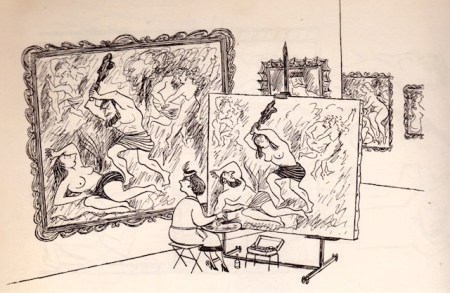In the New York Times on the 14th, an obituary by William Grimes, “Anatol Kovarsky, New Yorker Cartoonist for Decades, Dies at 97”:
Anatol Kovarsky, an artist and illustrator whose sense of whimsy and the absurd made him a fixture at The New Yorker from the late 1940s through the 1960s as both a cartoonist and a cover artist, died on June 1 at his home in Manhattan. He was 97.
Mr. Kovarsky, a master of the wordless visual gag, produced nearly 300 cartoons for The New Yorker. His first, published on March 1, 1947, showed two museum visitors peering at each other in surprise as they looked through the hole in a large Henry Moore-like nude.
Some cartoons had captions, others did not. All had a subtle, intellectual twist.
An artist in his studio, surrounded by great paintings for inspiration, carefully draws a counterfeit bill. A Mayan chief, standing before an enormous ornate stone calendar, chides the hapless artist: “No, no, no! Thirty days hath September!”
A man floating on a raft in the ocean, about to be engulfed by Hokusai’s famous wave, says to his fellow castaway, “We’re in Japanese waters, that’s for sure.”
Mr. Kovarsky let his imagination roam freely for his covers, which Art News, in 1978, called “wry and often beautiful excursions into pattern, color, movement and American life.”
Depending on the occasion, he might depict the vast parking lot at a public beach, small marching bands assembled for a St. Patrick’s Day or, in a reference to the 1960 Olympic Games, figures from a Grecian urn running over hurdles, lifting weights and fencing.
He was fond of multiplying figures or shapes to create a quilt or frieze pattern, a style that allowed him to play ingenious variations on a single theme. In all, he produced 40 covers for the magazine, starting in the late 1950s.
Much of his work was about artists or the art world, wryly observed. A painter using a live woman model (lashed to wood) to paint a ship’s figurehead:.
And a woman copyist, faced with some version of the rape of the Sabine women, transposes male and female
Many of his covers were appreciations of public life in New York City. Or of public liofe in general, as on the cover of hhis 1956 book:
His early life was a story all of its own. From Grimes’s obit:
Anatoly Mironovich Kovarsky was born on April 6, 1919, in Moscow, to a family of wealthy assimilated Jews. His father, Miron, studied piano at the St. Petersburg Conservatory, where he met his future wife, Zinaida Eisenstadt, a singer.
After the Russian Revolution, Anatol’s father was imprisoned briefly by the Bolsheviks and eventually took his family to Poland, where their surname was spelled Kowarski. After graduating from secondary school in Warsaw, Anatol was sent to Vienna to study economics, as preparation for entering the family leather business. Indulging his real passion, he took lessons from a drawing master on the side.
Abandoning economics, he enrolled in the École Nationale Supérieure des Beaux Arts in Paris, where he studied with the post-Impressionist painter Charles Guérin. He also took lessons at the school of the Cubist painter André Lhote.
When the German Army advanced on Paris, he fled with his parents, who had joined him, to Nice and then to Casablanca. In December 1941, the family emigrated to the United States.
Note the succession of languages: Russian, Polish, German, French, English.




Leave a Reply